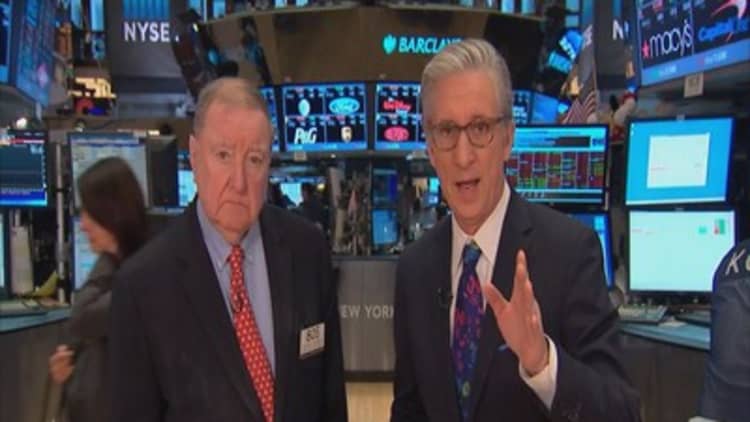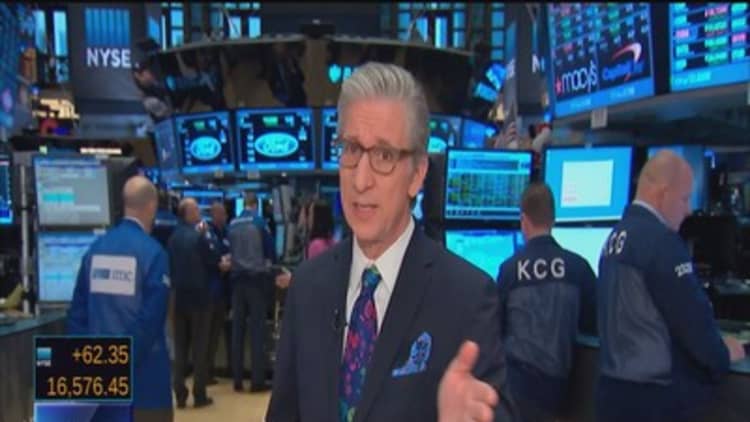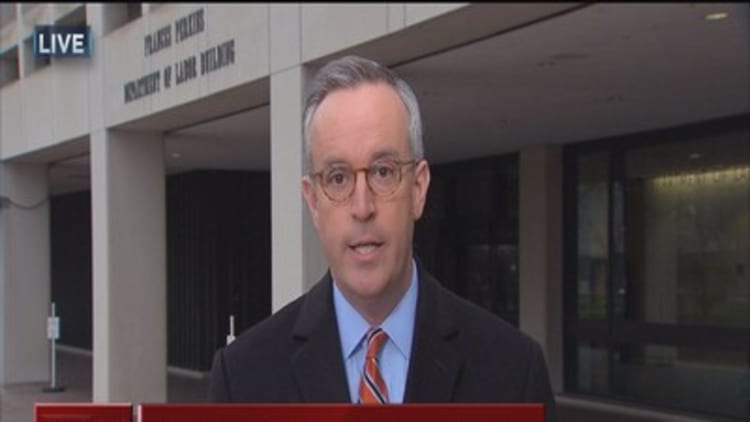



U.S. stocks closed about 1 percent lower Friday, ending the year's first trading week with sharp losses as concerns about China and global economic slowdown persisted. (Tweet This)
The Dow Jones industrial average and S&P 500 had their worst first five-day performance of a year in history, according to data from Howard Silverblatt, senior index analyst at S&P Dow Jones Indices. The S&P 500 lost $1.05 trillion this week, he said.
The major indexes closed out the week with losses of nearly 6 percent or more, their worst since 2011. The Russell 2000 also had its worst week in more than four years.
Read More5 things we've learned so far from a weird 2016
The major averages struggled for gains throughout the session before turning lower as the close approached.
"I don't think anyone wants to take on any risk for the weekend. … You just had the worst week in the start of the (year in) market history. Why would you want to go out long?" said Jeremy Klein, chief market strategist at FBN Securities.
The Dow Jones industrial average closed near session lows, down about 167 points, more than giving up opening gains of 137 points. Apple closed half a percent higher but lost nearly 7.9 percent for the week.
The S&P 500 closed down more than 1 percent, holding within 10 percent of its 52-week intraday high after earlier falling more than 10 percent from that level to briefly trade in correction territory.
The Dow and Nasdaq composite remained more than 10 percent below their 52-week intraday highs after closing there Thursday on speculation of further weakening in the Chinese yuan.
"I just think there's an underlying nervousness that we're going to see further turbulence out of China," said David Lefkowitz, senior equity strategist at UBS Wealth Management Americas. Performance in U.S. stocks depends "on willingness to believe the expansion is intact and the U.S. is going to remain relatively unaffected."
Financials led all S&P 500 sectors lower in the close and was the second-worst sector on the week.
Six-month weekly performance
Energy stocks weighed as WTI struggled to hold the $33 level. U.S. crude settled down 11 cents, or 0.33 percent, at $33.16 a barrel, down more than 10 percent for the week as oversupply concerns remained. The U.S. oil rig count showed a decline of 34 from last week, Baker Hughes said.
"I think everyone knows this isn't just about China. I think if it were, your focus would be much more specifically on China. ... It's the oil story. You don't want any important assets to be moving lower," said Quincy Krosby, market strategist at Prudential Financial.
U.S. stock index futures were higher ahead of the open, helped by a good December jobs report and stabilization in Chinese markets and currency.
Read MorePeople's Bank of China guides yuan up but weak outlook remains
"China continues to be a very near-term focus. Also, we're positioning (for when) the next Fed hike will be. Now it seems March will be the earliest," said Myles Clouston, senior director at Nasdaq.
"There's a lot of moving parts right now in the economy and investors are struggling right now to get a sense of what the next three to six months look like," he said.
The Atlanta Fed lowered its GDPNow forecast for real GDP growth (seasonally adjusted annual rate) in the fourth quarter of 2015 to 0.8 percent, down from 1.0 percent, after data showed wholesale inventories fell 0.3 percent in November.
The last nonfarm payrolls report for 2015 showed creation of 292,000 jobs, topping expectations. The unemployment rate was 5.0 percent. Average hourly earnings declined one cent, for an annualized gain of 2.5 percent, mostly because wages were unusually weak in December 2014, Reuters said.
"I think this is right in-line with what the Fed is planning on," said Tara Sinclair, chief economist at Indeed. "I don't think it's a big enough number for them to change their plans."
Expectations for Federal Reserve rate hikes in 2016 rose Friday after the jobs report. Two more employment reports and other data are due before the central bank is next expected to consider another rate rise, in March.
Read MoreJobs report dampens US recession speculation
Treasury yields held lower, with the at 0.92 percent and the 10-year yield at 2.11 percent.
San Francisco Fed President John Williams, a non-voting member, said Friday that four rate hikes is consistent with the gradual path the Fed has indicated, while it will take three years to reach a stable funds rate. He added that very low is the "new normal for interest rates." Headwinds from abroad, the stronger dollar, require continued accommodation, he said.
He added that two percent inflation is likely by the end of 2017, according to Dow Jones.
Another non-voting Fed member, Richmond Fed President Jeffrey M. Lacker, said in a Dow Jones report that the December employment data showed "very strong growth."
Both Williams and Lacker were members of the Federal Open Market Committee in 2015 when the central bank raised rates.
The U.S. dollar index held about 0.2 percent higher against major world currencies, with the euro near $1.09 and the yen at 117.56 yen against the greenback.
European stocks closed sharply lower, with the STOXX 600 and German DAX posting their biggest weekly losses since August 2011.
Asian stocks closed mixed, with the Nikkei slightly lower but the Shanghai Composite up nearly 2 percent Friday, one day after a seven percent stock drop triggered a circuit breaker and forced Chinese markets to close early for the second time in a week.
Chinese authorities suspended the newly implemented circuit breaker system Thursday morning ET.
The People's Bank of China said Friday it would further liberalize interest rates, Reuters reported. The central bank also said it would make the yuan more international and keep the currency basically stable, among other policy measures.
"Things in China are certainly going through a transition. We're not taking down our growth estimates for China. But they have a lot of wood to chop," UBS' Lefkowitz said. "There's been a lot of whipsaw in terms of China policy that's creating more uncertainty."
UBS said in its 2016 outlook it expects China's economy to grow 6.2 percent this year.
Major U.S. Indexes
Twitter closed down more than 1 percent after earlier hitting a fresh all-time low of $19.60 a share.
Read MoreEarly movers: FDX, MSFT, K, DD, BBBY, TWX, AVP & more
The Dow Jones industrial average closed down 167.65 points, or 1.02 percent, at 16,346.45, with Cisco leading decliners and Microsoft and Apple the only gainers.
The Dow fell 6.19 percent for the week, with JPMorgan Chase and Boeing down more than 10 percent as the worst performers. Only Wal-Mart held higher for the week, up 3.65 percent.
The closed down 21.06 points, or 1.08 percent, at 1,922.03, with financials leading all 10 sectors lower.
The index fell 5.96 percent for the week with all sectors lower, led by a 7.82 percent decline in materials.
The Nasdaq composite closed down 45.80 points, or 0.98 percent, at 4,643.63.
The Nasdaq lost 7.26 percent for the week.
The Dow transports closed 0.7 percent lower, for a weekly decline of 7.49 percent.
The CBOE Volatility Index (VIX), widely considered the best gauge of fear in the market, was near 27.
About two stocks declined for every advancer on the New York Stock Exchange, with an exchange volume of 1.1 billion and a composite volume of 4.6 billion.
High-frequency trading accounted for 49 percent of January's daily trading volume of about 8.43 billion shares, according to TABB Group. During the peak levels of high-frequency trading in 2009, about 61 percent of 9.8 billion of average daily shares traded were executed by high-frequency traders.
Gold futures for February delivery settled down $9.90 at $1,097.90 an ounce.
—Reuters contributed to this report.





